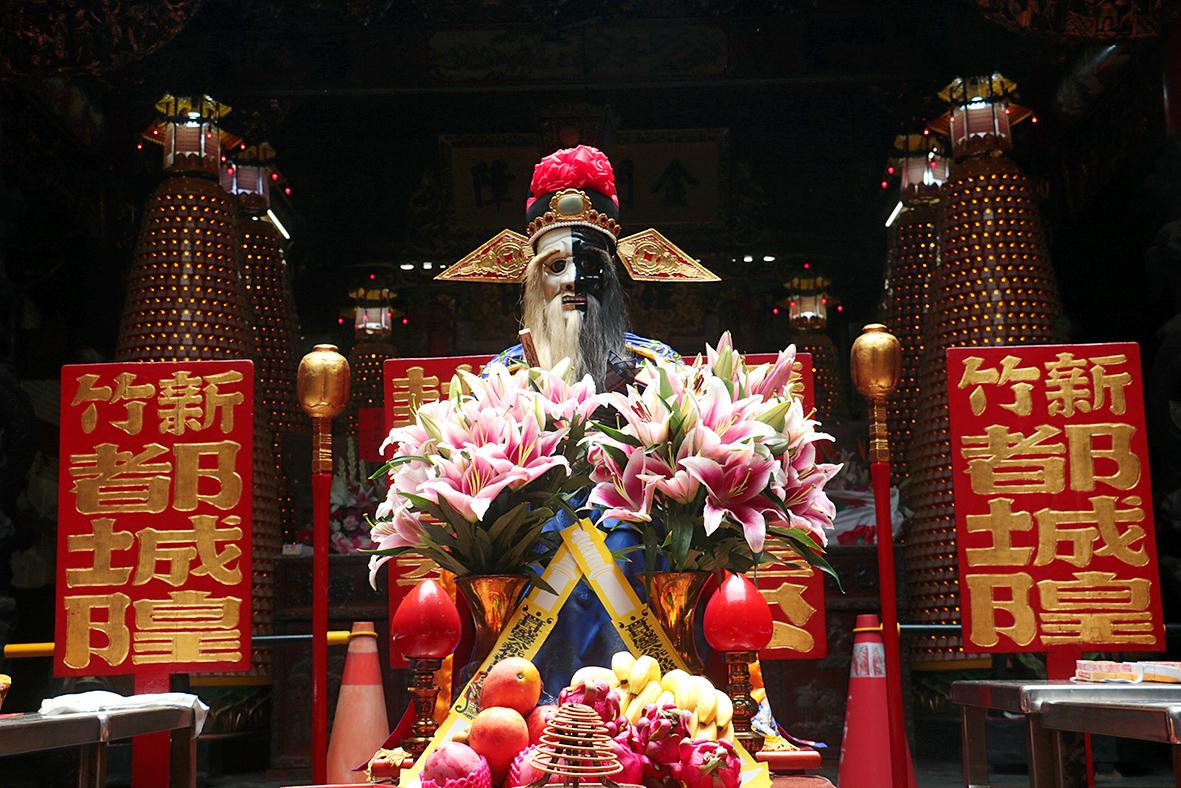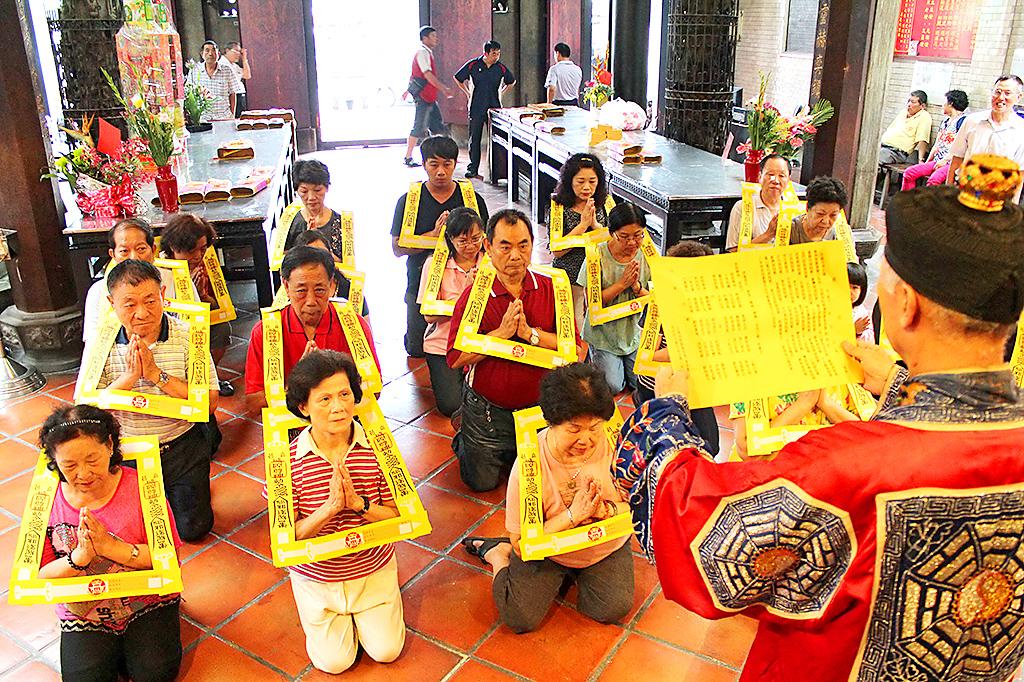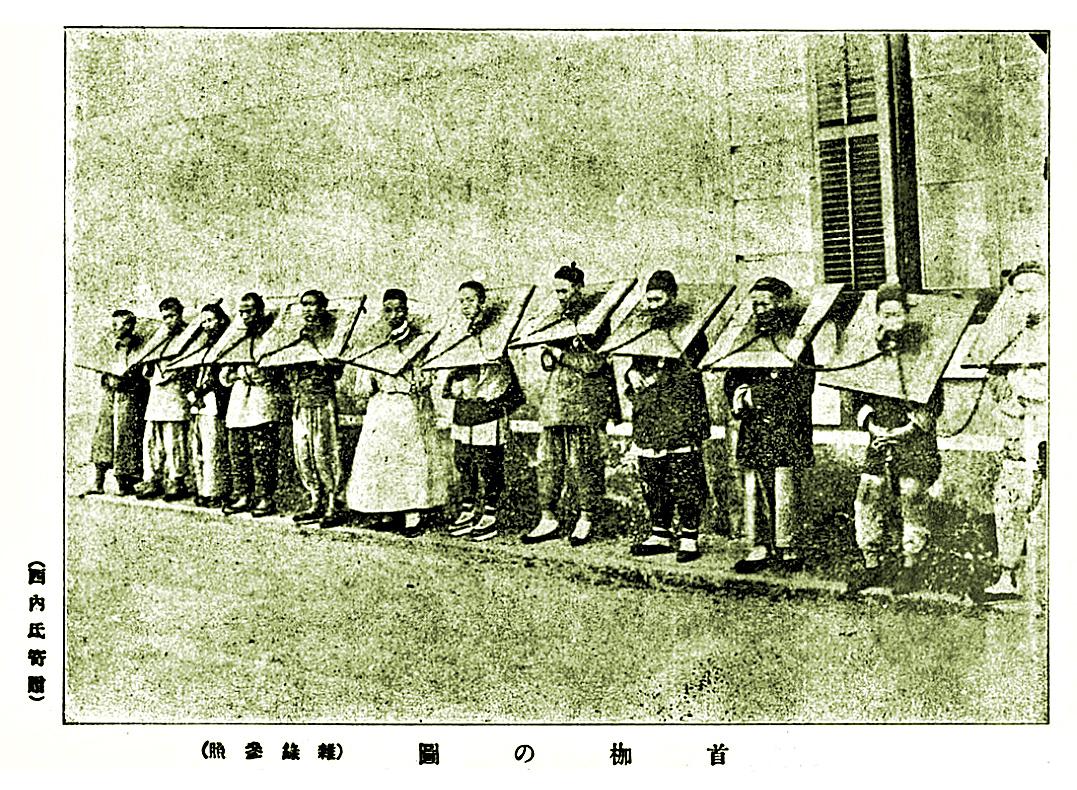Aug. 17 to Aug. 23
Ms Liu (劉) had a lot to be sorry about over the years.
She was rude to her parents, feuded with coworkers and often succumbed to greed. So when Chiayi’s Cheng Huang Temple (城隍廟) started offering “cangue processions” (夯枷) in 2014 at end of Ghost Month, Liu immediately signed up, she told the Liberty Times (Taipei Times’ sister newspaper).

Photo courtesy of Hsinchu County Government
A cangue is a large wooden board that was fitted around a criminal’s neck, a practise dating back to antiquity. Some included holes for arms. During the Qing Dynasty, a cangue could weight up to 40kg, and prisoners were paraded around the streets as a form of torture and humiliation.
Fortunately, Liu only had to wear a symbolic one made of paper. The participants announce, “I am a sinner and I’m willing to repent and correct my mistakes.” At the end of the procession, they present a “spiritual petition” (疏文) to the black-and-white faced yinyangsi (陰陽司), who serves as a chief assistant to the City God. They then burn the cangues along with the petitions.
Participants do not have to have committed any serious crimes. A woman surnamed Lou (婁) says she had a argument with her husband and badmouthed him to her friends, and she joined to alleviate her conscience and pray for their relationship.

Photo: Yu Hsueh-lan, Taipei Times
Chiayi’s ritual was stopped for about 60 years before its 2014 revival, while the event at Hsinchu’s City God Temple endured and remains the best-known version in Taiwan. It continues to grow in popularity, as last year’s procession in Hsinchu saw 2,310 cangue bearers, while Chiayi’s edition boasted about 300 participants.
This year, Hsinchu’s cangue procession takes place on Wednesday, which is the first day of Ghost Month, while Chiayi’s will fall on the day after the end of Ghost Month on Sept. 17.
TRADITION OF REPENTANCE

Photo courtesy of Trans-Asia Photography Review
City Gods are considered administrative and judicial officials of the underworld, and during the Ming and Qing dynasties, the temples they reside in have served as a spiritual counterparts to local government offices.
Many of the earlier City God Temples in Taiwan were set up by Qing officials, who built them in the administrative center of each new district. At the end of Qing rule of Taiwan in 1895, there were 15 state-built City God Temples and 16 private ones. They were given ranks and jurisdictions according to Qing administrative levels, and Hsinchu’s temple received the highest “capital” rank in 1889. Today there are over 90 temples across Taiwan with the City God as main deity.
The unique cangue ritual developed due to the City God’s reputation as a magistrate-deity.
The nation’s earliest description of cangue procession is found in a 1871 Qing gazetteer, which mentioned men and women walking in a Chungyuan Festival (中元, 15th day of Ghost Month) procession with paper cangues around their necks.
There are several types of paper cangues. Hsinchu’s version is a triangle symbolizing three swords against the bearer’s neck, while Chiayi employs a rectangle that looks more like the traditional wooden contraption.
According to the book Interaction Between Humans and Ghosts (人與鬼之交流) by Tsai Yi-hsin (蔡翊鑫), the Hsinchu City God Temple’s cangue ritual was first held in 1854. Back then, participants wore actual wooden cangues, and there was no procession since “sinners” were free to visit the yinyangsi anytime between the first and 15th day of Ghost Month. These wooden cangues have been lost to time.
The Canadian missionary George Leslie Mackay recalls in his diary seeing this procession in 1879 in Hsinchu, noting that many participants wore triangle cangues made by connecting three swords around their necks.
A local Hsinchu gazetteer from 1894 details local Chungyuan Festival celebrations through a poem, describing in one stanza an all-woman cangue procession.
It is unclear when Hsinchu’s procession was moved to the first day of Ghost Month.
The Taiwan Daily News (台灣日日新報) reported in 1908 that participants used sword, bamboo and paper cangues, but by 1918 it was all paper. The 1918 article, which was published about a week before the event, notes that 9,000 cangues had already been sold, showing that it was a much grander affair compared to today.
The procession continued to swell in numbers as a 1928 report notes that the temple prepared 12,000 paper cangues.
The cangues were a significant source of income for the temples, and still are. It costs NT$600 to participate in both Hsinchu and Chiayi, meaning that the Hsinchu temple earned over NT$1.3 million last year from the ritual. In 1882, a man named Liu Lue (柳略) was arrested for privately selling them. His punishment could not be more apt — he was fitted with a wooden cangue and paraded through the streets.
The ritual’s lowest point came in 1997, when the temple canceled it due to just six people signing up.
OTHER LOCALES
In 2014, Chiayi’s Cheng Huang Temple, built in 1715 and also dedicated to the City God, held a special night patrol for the second year in a row upon the end of ghost month to cleanse the area of lingering demons.
The temple told the Liberty Times that 2014 was especially turbulent — that year saw the Sunflower student movement, a random MRT slashing incident, the TransAsia Airways (復興航空) plane crash in Penghu, a series of deadly gas explosions in Kaohsiung and a truck attack on the Presidential Office, just to name a few events.
That year, the temple included the cangue ritual in its Ghost Month festivities for the first time in about 60 years.
The history of Chiayi Cheng Huang Temple’s cangue ritual is not well-documented. Eighty-year-old honorary temple director Yeh Yuan-chu (葉源助) recalls seeing an impressive procession when he was young, but does not know why it was discontinued.
Taipei’s Xiahai City God Temple also held this ritual at one point. Hung Chen-chin (洪陳勤), who grew up in Dadaocheng in the 1920s, tells Academia Historica that she recalls seeing a procession during the City God’s birthday festivities. Photos taken in 1949 still show participants wearing cangues, but the practice did not survive to modern day.
Taiwan in Time, a column about Taiwan’s history that is published every Sunday, spotlights important or interesting events around the nation that either have anniversaries this week or are tied to current events.

April 14 to April 20 In March 1947, Sising Katadrepan urged the government to drop the “high mountain people” (高山族) designation for Indigenous Taiwanese and refer to them as “Taiwan people” (台灣族). He considered the term derogatory, arguing that it made them sound like animals. The Taiwan Provincial Government agreed to stop using the term, stating that Indigenous Taiwanese suffered all sorts of discrimination and oppression under the Japanese and were forced to live in the mountains as outsiders to society. Now, under the new regime, they would be seen as equals, thus they should be henceforth

Last week, the the National Immigration Agency (NIA) told the legislature that more than 10,000 naturalized Taiwanese citizens from the People’s Republic of China (PRC) risked having their citizenship revoked if they failed to provide proof that they had renounced their Chinese household registration within the next three months. Renunciation is required under the Act Governing Relations Between the People of the Taiwan Area and the Mainland Area (臺灣地區與大陸地區人民關係條例), as amended in 2004, though it was only a legal requirement after 2000. Prior to that, it had been only an administrative requirement since the Nationality Act (國籍法) was established in

With over 100 works on display, this is Louise Bourgeois’ first solo show in Taiwan. Visitors are invited to traverse her world of love and hate, vengeance and acceptance, trauma and reconciliation. Dominating the entrance, the nine-foot-tall Crouching Spider (2003) greets visitors. The creature looms behind the glass facade, symbolic protector and gatekeeper to the intimate journey ahead. Bourgeois, best known for her giant spider sculptures, is one of the most influential artist of the twentieth century. Blending vulnerability and defiance through themes of sexuality, trauma and identity, her work reshaped the landscape of contemporary art with fearless honesty. “People are influenced by

The remains of this Japanese-era trail designed to protect the camphor industry make for a scenic day-hike, a fascinating overnight hike or a challenging multi-day adventure Maolin District (茂林) in Kaohsiung is well known for beautiful roadside scenery, waterfalls, the annual butterfly migration and indigenous culture. A lesser known but worthwhile destination here lies along the very top of the valley: the Liugui Security Path (六龜警備道). This relic of the Japanese era once isolated the Maolin valley from the outside world but now serves to draw tourists in. The path originally ran for about 50km, but not all of this trail is still easily walkable. The nicest section for a simple day hike is the heavily trafficked southern section above Maolin and Wanshan (萬山) villages. Remains of